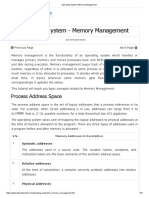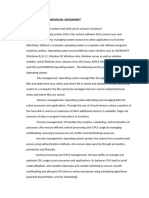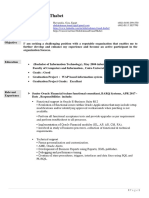RK Osy 2
RK Osy 2
Uploaded by
acscollage371Copyright:
Available Formats
RK Osy 2
RK Osy 2
Uploaded by
acscollage371Original Title
Copyright
Available Formats
Share this document
Did you find this document useful?
Is this content inappropriate?
Copyright:
Available Formats
RK Osy 2
RK Osy 2
Uploaded by
acscollage371Copyright:
Available Formats
MEMORY MANAGEMENT
INTRODUCTION
Memory Management is the process of controlling and
coordinating computer memory, assigning portions known as blocks to various
running programs to optimize the overall performance of the system. It is the
most important function of an operating system that
manages primary memory. It helps processes to move back and forward betwee
n themain memory and execution disk. It helps OS to keep track of every
memory location, irrespective of whether it is allocated to some process or it
remains free.
It checks how much memory is to be allocated
to processes. It decides which process will get memory at what time. It tracksw
henever some memory gets freed or unallocated and correspondingly it updates
the status.
Memory management moves processes between
storage drives and memory. It controls which processes
get priority in your computer's main memory and which
are sent to alternate storage areas.
ACS’S DIET ASHTI Page 1
MEMORY MANAGEMENT
Aims/Benefits of Micro Project :
Efficient memory usage: The goal is to use a computer's memory resources
efficiently.
Prevent crashes: Memory management prevents conflicts and crashes by
keeping track of which parts of memory are in use and which are available.
Optimize memory usage: Memory management optimizes memory usage to
avoid wastage.
Make processes more efficient: Memory management makes computer
processes more efficient by allocating memory to processes that need more and
releasing memory from applications or programs that may no longer use it.
Enable multitasking: Proper memory management enables seamless
multitasking.
makes computer processes more efficient by allocating memory to
processes that need more and releasing memory from applications or
programs that may no longer use it.
Improves performance
Memory management reduces memory access operations, which are CPU-heavy
tasks. This improves computer speed and stability.
Protects data and processes
Memory management ensures that processes only use the memory they are
given and enforces access permissions.
ACS’S DIET ASHTI Page 2
MEMORY MANAGEMENT
What is memory ?
The main memory is central to the operation of a modern computer. Main
Memory is a large array of words or bytes, ranging in size from hundreds of
thousands to billions. Main memory is a repository of rapidly available
information shared by the CPU and I/O devices. Main memory is the place
where programs and information are kept when the processor is effectively
utilizing them. Main memory is associated with the processor, so moving
instructions and information into and out of the processor is extremely fast.
Main memory is also known as RAM (Random Access Memory). This memory
is a volatile memory. RAM lost its data when a power interruption occurs.
memory refers to the computer hardware and management mechanisms used to
store data and programs while they are being used or processed by the CPU.
This includes both primary memory (such as RAM) and secondary memory
(such as hard drives or SSDs), though the focus in operating system design is
typically on managing primary memory, since it directly impacts performance.
Primary Memory (RAM - Random Access Memory): This is the
temporary storage used by the system to store data that is actively being used or
processed. RAM is fast but volatile, meaning it loses its contents when the
system is powered off.
Secondary Memory: Non-volatile storage such as hard drives (HDDs),
solid-state drives (SSDs), and other long-term storage devices. These devices
store data permanently or until explicitly deleted by the user or system.
ACS’S DIET ASHTI Page 3
MEMORY MANAGEMENT
ACS’S DIET ASHTI Page 4
MEMORY MANAGEMENT
Fig:- Memory Management
WHAT IS MEMORY MANGEMENT ?
The main memory is central to the operation of a modern computer. Main Memory is a
large array of words or bytes, ranging in size from hundreds of thousands to
billions. Main memory is a repository of rapidly available information shared
by the CPU and I/O devices. Main memory is the place where programs and
information are kept when the processor is effectively utilizing them. Main
memory is associated with the processor, so moving instruction and information into
and out of the processor is extremely fast. Main memory is also known as RAM
(Random Access Memory). This memory is a volatile memory. RAM lost its
data when a power interruption occurs.
The operating system must manage the allocation and deallocation of memory
to different processes running on the system. Key tasks include:
Memory Allocation: Assigning portions of memory to various processes
or programs.
Memory Protection: Preventing one process from accessing the memory
space allocated to another, ensuring data integrity and security.
Memory Swapping: When the system runs low on RAM, it may move
some of the data from RAM to secondary storage in a process called
swapping or paging, allowing the system to continue running while
freeing up memory.
Virtual Memory: A technique that creates an "illusion" of a larger
amount of RAM than physically exists by using part of the secondary
storage (disk space) to extend the available memory. This allows
programs to run even if they require more memory than is physically
available.
ACS’S DIET ASHTI Page 5
MEMORY MANAGEMENT
ACS’S DIET ASHTI Page 6
MEMORY MANAGEMENT
Why Memory Management is Required :
Allocate and de-allocate memory before and after process execution.
To keep track of used memory space by processes.
To minimize fragmentation issues.
To proper utilization of main memory.
To maintain data integrity while executing of process.
Now we are discussing the concept of logical address space and
Physical address space:
Logical and Physical Address Space:
ACS’S DIET ASHTI Page 7
MEMORY MANAGEMENT
Logical Address space:
An address generated by the CPU is known as a “Logical Address”. It
is also known as a Virtual address. Logical address space can be
defined as the size of the process. A logical address can be changed.
Physical Address space:
An address seen by the memory unit (i.e the one loaded into the
memory address register of the memory) is commonly known as a
“Physical Address”. A Physical address is also known as a Real
address. The set of all physical addresses corresponding to these
logical addresses is known as Physical address space. A physical
address is computed by MMU. The physical address always remains
constant.
Static and Dynamic Loading:
ACS’S DIET ASHTI Page 8
MEMORY MANAGEMENT
To load a process into the main memory is done by a loader. There
are two different types of loading
Static loading:-loading the entire program into a fixed address. It
requires more memory space.
Dynamic loading:-
The entire program and all data of a process must be in physical
memory for the process to execute. So, the size of a process is limited
to the size of physical memory. To gain proper memory utilization,
dynamic loading is used. In dynamic loading, a routine is not loaded
until it is called. All routines are residing on disk in a re locatable load
format. One of the advantages of dynamic loading is that unused
routine is never loaded. This loading is useful when a large amount of
code is needed to handle it efficiently .
ACS’S DIET ASHTI Page 9
MEMORY MANAGEMENT
Static and Dynamic linking:
To perform a linking task a linker is used. A linker is a program that
takes one or more object files generated by a compiler and combines
them into a single executable file.
Static linking:
In static linking, the linker combines all necessary program modules
into a single executable program. So, there is no runtime dependency.
Some operating systems support only static linking, in which system
language libraries are treated like any other object module.
Dynamic linking:
The basic concept of dynamic linking is similar to dynamic loading.
In dynamic linking, “Stub” is included for each appropriate library
routine reference. A stub is a small piece of code. When the stub is
executed, it checks whether the needed routine is already in memory
or not. If not available then the program loads the routine into
memory.
ACS’S DIET ASHTI Page 10
MEMORY MANAGEMENT
Fragmentation:
Fragmentation is defined as when the process is loaded and removed
after execution from memory, it creates a small free hole. These holes
cannot be assigned to new processes because holes are not combined
or do not fulfill the memory requirement of the process. To achieve a
degree of multiprogramming, we must reduce the waste of memory or
fragmentation problems.
In the operating systems two types of fragmentation:
a. Internal Fragmentation
b. External Fragmentation
ACS’S DIET ASHTI Page 11
MEMORY MANAGEMENT
Paging :
Paging is a memory management scheme that eliminates
the need for contiguous allocation of physical memory.
This scheme permits the physical address space of a
process to be non-contiguous.
Logical Address or Virtual Address (represented in bits): An
address generated by the CPU
Logical Address Space or Virtual Address Space (represented in
words or bytes): The set of all logical addresses generated by a
program
Physical Address (represented in bits): An address actually available
on a memory unit
Physical Address Space (represented in words or bytes): The set of
all physical addresses corresponding to the logical addresses
ACS’S DIET ASHTI Page 12
MEMORY MANAGEMENT
Advantages of Memory Management:-
Memory management keeps track of each and every
memory location, regardless of either it is allocated to
some process or it is free.
It checks how much memory is to be allocated to
processes.
It decides which process will get memory at what time.
It manages swap spaces, which store inactive pages of
memory
It enhance multitasking
Prevent crashes and errors due to memory conflict
ACS’S DIET ASHTI Page 13
MEMORY MANAGEMENT
Disadvantages of memory management:-
Availability of external fragmentation.
Algorithms of memory managements are costly.
Segmentation discovers free memory areas sufficiently
large.
Paging keeps rundown of free pages.
Segments of inconsistent size not fit also for trading.
ACS’S DIET ASHTI Page 14
MEMORY MANAGEMENT
CONCLUSION
Memory management ensure that blocs of memory space are properly manage
and allocated , so the operating system (OS) , applications and other running
processes have the memory they need to carry out their operation.
Memory management keep track of each and every memory location,
regardless of either it is allocated to some process or it is free. It checks how
much memory is to be allocated to processes. It decides which process will get
memory at what time. It tracks whenever some memory gets freed or
unallocated and correspondingly It updates the status.
ACS’S DIET ASHTI Page 15
MEMORY MANAGEMENT
REFERANCE
1) Third year Operatin System book
2) Figures are download from www.msbte.com
3) www.google.com
4) www.geeksforgeeks.com
5) For this project we used a MS-word
ACS’S DIET ASHTI Page 16
You might also like
- Visual Data Storytelling With Tableau by Lindy RyanDocument450 pagesVisual Data Storytelling With Tableau by Lindy RyanVictor Fuentes Lastiri83% (18)
- Leet Code SQL Questions 2Document105 pagesLeet Code SQL Questions 2gopisrikanth88No ratings yet
- Metainfo 2Document58 pagesMetainfo 2Bogdan GabrielNo ratings yet
- Chapter 3-Memory ManagementDocument51 pagesChapter 3-Memory ManagementdsweetalkerNo ratings yet
- Oracle: Oracle Cloud Infrastructure (OCI) Architect Associate Exam 2019Document6 pagesOracle: Oracle Cloud Infrastructure (OCI) Architect Associate Exam 2019Diganta MajumderNo ratings yet
- Big Data, Predictive Analytics, and Data Analytics in Construction IndustryDocument2 pagesBig Data, Predictive Analytics, and Data Analytics in Construction IndustryPrateek VyasNo ratings yet
- All Document Reader 1726040550514Document9 pagesAll Document Reader 1726040550514matetisantosh37No ratings yet
- Memory Management in Operating System - GeeksforGeeksDocument18 pagesMemory Management in Operating System - GeeksforGeeksabubakarkhalid5864No ratings yet
- Memory Management - Module 4Document38 pagesMemory Management - Module 4Saurabh YadavNo ratings yet
- Memory Management - PQDocument27 pagesMemory Management - PQSaurabh YadavNo ratings yet
- Presentation of OSDocument27 pagesPresentation of OSUmer NaveedNo ratings yet
- Memory Management in Operating System - GeeksforGeeksDocument19 pagesMemory Management in Operating System - GeeksforGeeksanilNo ratings yet
- CS Oss 3Document82 pagesCS Oss 3cjjasmin3No ratings yet
- Os Unit-3 (Bca)Document19 pagesOs Unit-3 (Bca)Bot IdNo ratings yet
- Unit Iii-1Document14 pagesUnit Iii-1hemavallibatchu137No ratings yet
- FocusTaskReading 13Document7 pagesFocusTaskReading 13anniebabbie77No ratings yet
- Unit5 OsDocument20 pagesUnit5 Osईश्वर महालेNo ratings yet
- Os 1111Document39 pagesOs 1111Crazy JaatNo ratings yet
- Lecture 2Document26 pagesLecture 2princecboy001No ratings yet
- DPCO_UNIT-5Document30 pagesDPCO_UNIT-5ImranNo ratings yet
- OS Research ReportDocument7 pagesOS Research ReportNimra ShahNo ratings yet
- 1_introduction to OsDocument35 pages1_introduction to OsJisha C ThankappanNo ratings yet
- Os Unit - 4Document25 pagesOs Unit - 422wh1a1231No ratings yet
- Components of Operating SystemDocument5 pagesComponents of Operating SystemMARY JOY VILLARUEL100% (1)
- Type of Operating System ServicesDocument5 pagesType of Operating System ServicesmamtaNo ratings yet
- Textual Learning Material - Module 4Document46 pagesTextual Learning Material - Module 4Amir Irfan SayedNo ratings yet
- MemoryDocument2 pagesMemoryella1261996No ratings yet
- Operating System Memory ManagementDocument7 pagesOperating System Memory ManagementNgatia SamNo ratings yet
- Finals_Memory-ManagementDocument5 pagesFinals_Memory-Managementaidanavales1No ratings yet
- TuongAnhKiet Assessing Exercises of Chapter 8Document3 pagesTuongAnhKiet Assessing Exercises of Chapter 8Tưởng Anh KiệtNo ratings yet
- Additional Course Material: Computer BasicsDocument9 pagesAdditional Course Material: Computer BasicskaviatchennaiNo ratings yet
- Operating System - Memory Management: Process Address SpaceDocument10 pagesOperating System - Memory Management: Process Address SpaceNelson RajaNo ratings yet
- Memory Management BasicsDocument7 pagesMemory Management Basicsmichaelodera370No ratings yet
- Lecture NotesDocument10 pagesLecture Notesibraheembello31No ratings yet
- Working Set Model & LocalityDocument15 pagesWorking Set Model & LocalitySunimali PereraNo ratings yet
- Os - Memory Management in Operating SystemDocument10 pagesOs - Memory Management in Operating Systemluckysighania93No ratings yet
- Memory Management in Operating Systems ExplainedDocument9 pagesMemory Management in Operating Systems Explainedlalitmahato11No ratings yet
- Os Individual 041011Document10 pagesOs Individual 041011damasmaige6No ratings yet
- Ptech GRP 5Document16 pagesPtech GRP 5James BacolodNo ratings yet
- Virtual MemoryDocument14 pagesVirtual Memorymoupiyadas33No ratings yet
- Module 7 Memory ManagementDocument7 pagesModule 7 Memory ManagementnatsuNo ratings yet
- OS UNIT 4 NOTESDocument13 pagesOS UNIT 4 NOTESShlok GaikwadNo ratings yet
- Fundamentals of ITDocument42 pagesFundamentals of ITAditya KulkarniNo ratings yet
- Unit 7 ManagementDocument12 pagesUnit 7 ManagementCindy CortezNo ratings yet
- What Are A Process and Process Table?Document10 pagesWhat Are A Process and Process Table?JackNo ratings yet
- Reflective Essay of Operating SystemDocument15 pagesReflective Essay of Operating SystemaarkkadiyamNo ratings yet
- Os IndividualDocument9 pagesOs Individualdamasmaige6No ratings yet
- OS - Unit 1 - NotesDocument15 pagesOS - Unit 1 - Notestanay282004guptaNo ratings yet
- Revised and Updated by David SarneDocument18 pagesRevised and Updated by David SarneAyesha BabarNo ratings yet
- Lecture 28-33Document47 pagesLecture 28-33soomrokazim909No ratings yet
- OS Unit 1 NotesDocument48 pagesOS Unit 1 NotesHARSHA VINAY KOTNI HU21CSEN0100574No ratings yet
- Lecture 7 Memory and File Management by FQDocument29 pagesLecture 7 Memory and File Management by FQaina syafNo ratings yet
- CHAPTER FIVcoaEDocument18 pagesCHAPTER FIVcoaEMohammedNo ratings yet
- Os Unit-3Document44 pagesOs Unit-3vamsi.d124No ratings yet
- Os 3Document43 pagesOs 3Dhoni GamerNo ratings yet
- UNIT-4 OSDocument27 pagesUNIT-4 OSVinaykumarNo ratings yet
- Os 1Document64 pagesOs 1Sarathi MNo ratings yet
- OS Chapter 4Document16 pagesOS Chapter 4lalalata08No ratings yet
- Additional Course Material: Computer BasicsDocument9 pagesAdditional Course Material: Computer Basicssayhigaurav07No ratings yet
- NitishChandraSinghaDocument6 pagesNitishChandraSinghaAfzal MirNo ratings yet
- Memory Management in Linux Operating SystemDocument13 pagesMemory Management in Linux Operating SystemsnehaNo ratings yet
- Final Unit 5Document37 pagesFinal Unit 5n9166254105No ratings yet
- Operating System Components - Lesson 2-1Document6 pagesOperating System Components - Lesson 2-1Bright Alike ChiwevuNo ratings yet
- What Is Memory ManagementDocument2 pagesWhat Is Memory Managementdigupathania25No ratings yet
- Basic Power BI Interview Questions For FreshersDocument49 pagesBasic Power BI Interview Questions For Fresherssanjeev091988No ratings yet
- ?brutal Bypass 0.21.2 V2?Document12 pages?brutal Bypass 0.21.2 V2?bambelasanjiNo ratings yet
- Business Research Method (Final Assessment)Document4 pagesBusiness Research Method (Final Assessment)Jordan BennedoNo ratings yet
- Time: 3 Hour Max - Marks: 75: Model Question Paper Diploma in Computer EngineeringDocument4 pagesTime: 3 Hour Max - Marks: 75: Model Question Paper Diploma in Computer EngineeringSam JhonsonNo ratings yet
- How To Load Equipment Long Text in S - 4 HANA 2020 On Premise Using SAP Data Services - SAP BlogsDocument8 pagesHow To Load Equipment Long Text in S - 4 HANA 2020 On Premise Using SAP Data Services - SAP BlogsLohithNo ratings yet
- Manuscript Academic FailureDocument31 pagesManuscript Academic FailureNikki Carnalan100% (1)
- Single Part DrawingDocument118 pagesSingle Part DrawingAdi SumarnoNo ratings yet
- Uc 434 SDocument2 pagesUc 434 SlumanenNo ratings yet
- Ten Simple Rules For Creating A Good Data Management Plan: William K. MichenerDocument9 pagesTen Simple Rules For Creating A Good Data Management Plan: William K. MichenermohammedNo ratings yet
- Dsi 403Document176 pagesDsi 403Vitaly SavenkovNo ratings yet
- Date: - Total Marks: 50 Name: - Passing Marks: 35 Emp ID: - Passing Percentage: 70 % Time: 1 HourDocument7 pagesDate: - Total Marks: 50 Name: - Passing Marks: 35 Emp ID: - Passing Percentage: 70 % Time: 1 HourSUDHARSANA SNo ratings yet
- Resume GaneshDocument7 pagesResume Ganeshg_ramananNo ratings yet
- Senior Oracle Techno Functional Consultant AbdelRahman - Fouad - ThabetDocument3 pagesSenior Oracle Techno Functional Consultant AbdelRahman - Fouad - Thabetعبدالرحمن فؤادNo ratings yet
- How To Verify, View, and Turn Off Oracle 12c AuditsDocument2 pagesHow To Verify, View, and Turn Off Oracle 12c AuditsSaka KelyNo ratings yet
- Orgl 3321 ArtifactDocument14 pagesOrgl 3321 Artifactapi-727418963No ratings yet
- Index: Introduction To PL/SQLDocument167 pagesIndex: Introduction To PL/SQLnagamanicseNo ratings yet
- Master of Business Administration OF Bangalore University: A Study OnDocument5 pagesMaster of Business Administration OF Bangalore University: A Study OnMohanNo ratings yet
- A Statistical Approach To Bed Capacity Planning and Resource Allocation in Frederico Roman Tirador Sr. Memorial District HospitalDocument14 pagesA Statistical Approach To Bed Capacity Planning and Resource Allocation in Frederico Roman Tirador Sr. Memorial District HospitalLy Ann LoregaNo ratings yet
- sql-language-quick-referenceDocument203 pagessql-language-quick-referencevalmir.paixao.brNo ratings yet
- How To Open The Digital Boundaries in MapInfoDocument7 pagesHow To Open The Digital Boundaries in MapInfohuaweipsdNo ratings yet
- USA Insurance Copanies DBDocument12 pagesUSA Insurance Copanies DBMahesh MalveNo ratings yet
- ReDocument48 pagesReGnaneswari KumaresanNo ratings yet
- The Digital Library Project VOLUME 1: The World of Knowbots (Draft)Document48 pagesThe Digital Library Project VOLUME 1: The World of Knowbots (Draft)Md Kamruzzaman KhanNo ratings yet
- 09.DD Capacity - ThroughputDocument23 pages09.DD Capacity - Throughputnanganam1966No ratings yet
























































































